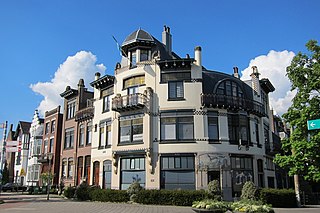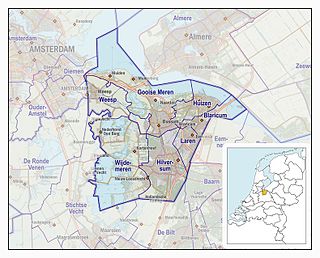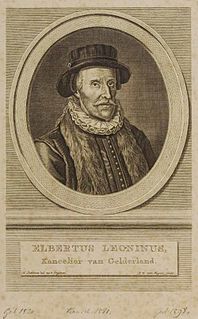
Arnhem is a city and municipality situated in the eastern part of the Netherlands. It is the capital of the province of Gelderland and located on both banks of the rivers Nederrijn and Sint-Jansbeek, which was the source of the city's development. Arnhem had a population of 159,265 in 2019 and is one of the larger cities of the Netherlands. The municipality is part of the Arnhem–Nijmegen metropolitan area which has a combined 736,500 inhabitants.

Doesburg is a municipality and a city in the eastern Netherlands in the province of Gelderland. Doesburg received city rights in 1237 and had a population of 11,148 in 2019. The city is situated on the right bank of river IJssel, at the confluence of river Oude IJssel. The municipality of Doesburg is part of the Arnhem-Nijmegen agglomeration region.

The Roman Catholic Cathedral Church of St. John (Sint-Janskathedraal) of 's-Hertogenbosch, North Brabant is the height of gothic architecture in the Netherlands. It has an extensive and richly decorated interior, and serves as the cathedral for the bishopric of 's-Hertogenbosch.
The Admiralty of Rotterdam, also called the Admiralty of de Maze, was one of the five Dutch admiralties in the Dutch Republic.

The Gooi is an area around Hilversum, in the centre of the Netherlands. It is a slightly hilly area characterised by its green landscape, its historical charm, the wealth of its inhabitants, and its villas. Het Gooi is known in the Netherlands as the home of the rich and famous.

Munsterbilzen Abbey was an abbey of Benedictine nuns in Munsterbilzen, Limburg, Belgium, founded in around 670 by Saint Landrada. It was plundered by Vikings in 881 but restored. From the 9th century it was dedicated to Saint Amor.

Elbertus Leoninus was the Latinized name of Elbert de Leeuw, Dutch jurist and statesman, who helped negotiate the Pacification of Ghent.

Saint Michael's Church is a Roman Catholic church in Ghent, Belgium built in a late Gothic style. It has rich interior decoration.

The Eastern Docklands is a neighborhood of Amsterdam, Netherlands, located between the IJ and the Amsterdam–Rhine Canal in the borough of Amsterdam-Oost. The harbor area was constructed in the late nineteenth century to allow for increasing trade with the Dutch East Indies; a new location was necessitated by the construction of the Amsterdam Centraal railway station, which replaced the old quays. East of the new station was a marshy area called De Rietlanden, with the Zeeburgerdijk, running via the Zeeburch, a fort, to the Zuiderzee.

The Saint Bavo Cathedral an 89-meter-tall Catholic, Gothic cathedral in Ghent, Belgium. It is the seat of the diocese of Ghent, is named for Saint Bavo of Ghent, and contains the well-known Ghent Altarpiece.
Peter van Mensch, born June 7, 1947 in Gouda, Netherlands is a Dutch scientist in the field of museology and a professor of Cultural Heritage at Amsterdam School of Arts.
The Abbey of Onze-Lieve-Vrouw ter Nieuwe Plant, formerly also Roesbrugge Abbey is a community of Augustinian canonesses belonging to the Congregation of Windesheim. The sisters are informally known as the Roesbrugge Dames - the Roesbrugge Ladies. Located in Roesbrugge from 1239 to the late 16th century, the community then moved into Ypres, West Flanders, Belgium, where it exists today. Its adjacent school is the Lyceum Onze Lieve Vrouw ter Nieuwe Plant.
Wilhelmina (Ineke) van Wetering was a Dutch anthropologist and Surinamist. She was born at 17 October 1934 in the Dutch city of Hilversum. When she was 10 years old, her father (ironmonger) had been executed by firing squad in the Second world war because of participating an illegal group who provided hiding places for people who were prosecuted by the Nazi-German army. She finished her secondary school in 1955, when she began her study sociology at the University of Amsterdam. In her later career she continued her work at the Vrije Universiteit Amsterdam.

The Saint Hippolytus Chapel is a chapel in the old city of Delft. It is one of the oldest buildings in Delft, and since 1967 it has been designated the Rijksmonument.
Van Maanen is the name of a Dutch patrician family, originating in the Duchy of Guelders. The family takes its name from the town of Manen, situated south of the city of Ede in the province of Gelderland.

Ninove Abbey, of which only the church remains in the center of Ninove, in the province of East Flanders, Belgium was a monastery of the Premonstratensian Order.

The Utrecht Schism was a diocesan feud in the Prince-Bishopric of Utrecht from 1423 to 1449, during which there was a major conflict over who was the legitimate prince-bishop of Utrecht. The war of succession was fought by Zweder van Culemborg and his brother Walraven van Meurs against Rudolf van Diepholt. The conflict mixed with the existing Utrecht factionalism between the Lichtenbergers and Lokhorsten and with the Hook and Cod wars raging in the County of Holland. Some scholars consider the Utrecht Schism to have ended in 1429.
Reinalda van Eymeren (1463–1540) was a religious sister in St Agnes Convent, Arnhem who has been proposed as the author of the highly influential, anonymous Middle Dutch spiritual text Die Evangelische Peerle, first published in 1535, and Vanden Tempel onser sielen, first published 1543.
Paul J. Begheyn is a Dutch Jesuit historian.












